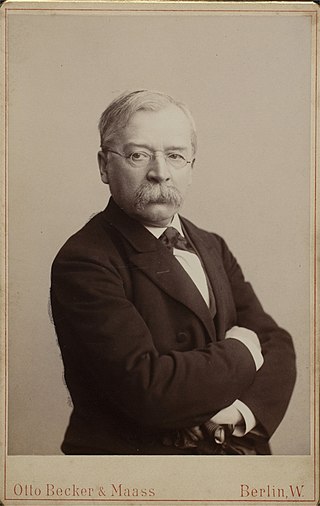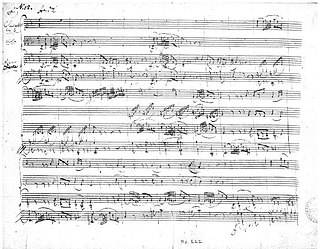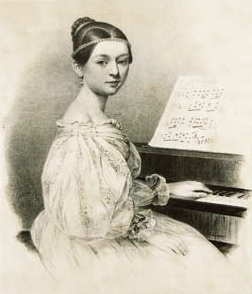A piano trio is a group of piano and two other instruments, usually a violin and a cello, or a piece of music written for such a group. It is one of the most common forms found in classical chamber music. The term can also refer to a group of musicians who regularly play this repertoire together; for a number of well-known piano trios, see below.

The Piano Quintet in E-flat major, Op. 44, by Robert Schumann was composed in 1842 and received its first public performance the following year. Noted for its "extroverted, exuberant" character, Schumann's piano quintet is considered one of his finest compositions and a major work of nineteenth-century chamber music. Composed for piano and string quartet, the work revolutionized the instrumentation and musical character of the piano quintet and established it as a quintessentially Romantic genre.

The Violin Sonata No. 1 in A minor, Op. 105 of Robert Schumann was written the week of 12– 16 September 1851. Schumann was reported to have expressed displeasure with the work. This was also the year of the premiere of the Rhenish symphony, and among compositions the substantial revision of the Fourth Symphony, the Third Piano Trio, the oratorio Der Rose Pilgerfahrt, a number of piano works and two of his concert overtures, Julius Caesar and Hermann und Dorothea after Goethe.
D minor is a minor scale based on D, consisting of the pitches D, E, F, G, A, B♭, and C. Its key signature has one flat. Its relative major is F major and its parallel major is D major.
The two Serenades, Op. 11 and 16, represent early efforts by Johannes Brahms to write orchestral music. They both date from after the 1856 death of Robert Schumann when Brahms was residing in Detmold and had access to an orchestra.

Woldemar Bargiel was a German composer.
The Piano Trio No. 3 in G minor by Robert Schumann was written in 1851, and is his opus 110. It has four movements:
- Bewegt, doch nicht zu rasch in G minor, in 6
8 time. In sonata form. - Ziemlich langsam in E-flat major, in 12
8 time and tempo 116 eighth notes to the minute. - Rasch in C minor, in 2
4 time and 138 quarter notes to the minute. A scherzo with two trios, with a tempo marking of Etwas zurückhaltend bis zm langsameren Tempo leading into the first trio, in C major with an upward chromatic theme, and a second trio in A-flat major which is more markedly rhythmic and diatonic in character. - Kräftig, mit Humor in G major, in common time and 104 quarter notes to the minute. There is a prominent episode in this rondo which quotes the C major trio from the scherzo.

A clarinet–viola–piano trio, often titled "Trio for Clarinet, Viola and Piano" is a work of chamber music that is scored for clarinet, viola, and piano; or is the designation for a musical ensemble of a group of three musicians playing these instruments. This combination of instruments differs from other combinations, as the viola and the clarinet share approximately the same musical range, but not the same tone quality.

Felix Mendelssohn's Piano Trio No. 1 in D minor, Op. 49, was completed on 23 September 1839 and published the following year. The work is scored for a standard piano trio consisting of violin, cello and piano. It is one of Mendelssohn's most popular chamber works and is recognized as one of his greatest along with his Octet, Op. 20. During the initial composition of the work, Mendelssohn took the advice of fellow composer Ferdinand Hiller to revise the piano part. Hiller wrote, "with his usual conscientious earnestness when once he had made up his mind, he undertook the length and rewrite the whole pianoforte part."

Antonín Dvořák composed his cycle of four Romantic Pieces, Op. 75, B. 150,, for violin and piano in January 1887. These four pieces are arranged from his previous composition, a trio for two violins and viola, known as Miniatures, Op. 75a, B. 149.

Johannes Brahms composed his Piano Trio No. 2 in C Major, Op. 87, between 1880 and 1882. It is scored for piano, violin and cello. He wrote this piece at the age of 49.

The Piano Quartet No. 3 in C minor, Op. 60, completed by Johannes Brahms in 1875, is scored for piano, violin, viola and cello. It is sometimes called the Werther Quartet after Goethe's The Sorrows of Young Werther. The premiere took place in Vienna on November 18th 1875 to an anxious public. Richard Wagner and his wife Cosima were in attendance.

Fantasiestücke for clarinet and piano, Op. 73, were written in 1849 by Robert Schumann. Though they were originally intended for clarinet and piano, Schumann indicated that the clarinet part could be also performed on violin or cello.

The Piano Quartet in E♭ major, Op. 47, was composed by Robert Schumann in 1842 for piano, violin, viola and cello. Written during a productive period in which he produced several large-scale chamber music works, it has been described as the "creative double" of his Piano Quintet, finished weeks earlier. Though dedicated to the Russian cellist Mathieu Wielhorsky, it was written with Schumann's wife Clara in mind, who would be the pianist at the premiere on 8 December 1844 in Leipzig.
Written in 1846, the Piano Trio in G minor, opus 17 by Clara Schumann was her only piano trio and was composed during her stay in Dresden 1845-1846. During the development of the Trio, she was going through hardships in life. Her husband Robert Schumann was extremely ill. This trio was completed during the summer of 1846 when they traveled to Norderney in attempts to improve Robert's health conditions. While in Norderney, Clara suffered from miscarriage. A year after the composition of her piano trio, Robert composed his first piano trio, op.63. It is seen that Clara's trio has had great influences on Robert's trio as they both share many interesting similarities. Their works were frequently paired at concerts.
A concert piece is a musical composition, in most cases in one movement, intended for performance in a concert. Usually it is written for one or more virtuoso instrumental soloists and orchestral or piano accompaniment.
The Piano Trio No. 2 in F major, Op. 80, by Robert Schumann was written in 1847. It has four movements:
- Sehr lebhaft in F major
- Mit innigem Ausdruck - Lebhaft in D-flat major
- In mässiger Bewegung in B-flat minor
- Nicht zu rasch in F major
Märchenerzählungen, Op. 132, is a trio composition by Robert Schumann in four movements for clarinet, viola and piano. He composed the clarinet-viola-piano trio in B-flat major, between 9 and 11 October 1853. The movements are connected by a motif (Kernmotiv). The work is dedicated to Schumann's pupil Albert Dietrich, and was published in 1854 by Breitkopf & Härtel.

The Piano Concerto in A minor, Op. 7, was composed by Clara Wieck, better known as Clara Schumann after her later marriage to Robert Schumann. She completed her only finished piano concerto in 1835, and played it first that year with the Leipzig Gewandhaus Orchestra, conducted by Felix Mendelssohn.











